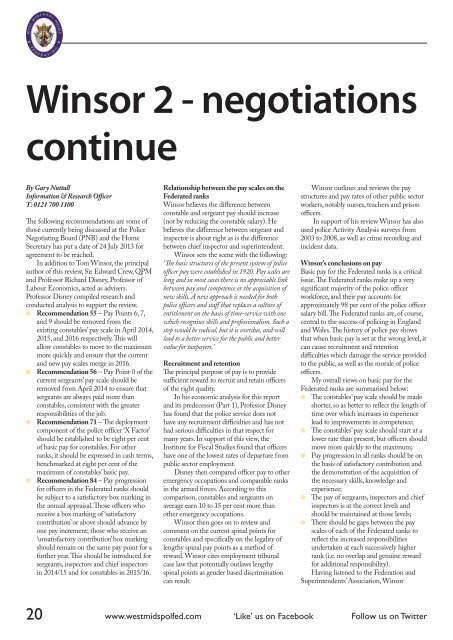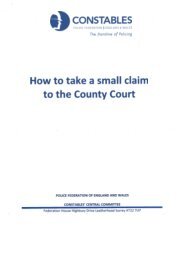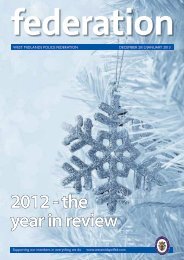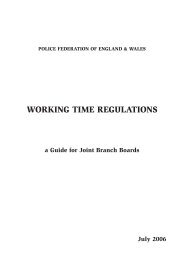Download - West Midlands Police Federation
Download - West Midlands Police Federation
Download - West Midlands Police Federation
You also want an ePaper? Increase the reach of your titles
YUMPU automatically turns print PDFs into web optimized ePapers that Google loves.
Winsor 2 - negotiations<br />
continue<br />
By Gary Nuttall<br />
Information & Research Officer<br />
T: 0121 700 1100<br />
The following recommendations are some of<br />
those currently being discussed at the <strong>Police</strong><br />
Negotiating Board (PNB) and the Home<br />
Secretary has put a date of 24 July 2013 for<br />
agreement to be reached.<br />
In addition to Tom Winsor, the principal<br />
author of this review, Sir Edward Crew, QPM<br />
and Professor Richard Disney, Professor of<br />
Labour Economics, acted as advisers.<br />
Professor Disney compiled research and<br />
conducted analysis to support the review.<br />
l Recommendation 55 – Pay Points 6, 7,<br />
and 9 should be removed from the<br />
existing constables’ pay scale in April 2014,<br />
2015, and 2016 respectively. This will<br />
allow constables to move to the maximum<br />
more quickly and ensure that the current<br />
and new pay scales merge in 2016.<br />
l Recommendation 56 – Pay Point 0 of the<br />
current sergeants’ pay scale should be<br />
removed from April 2014 to ensure that<br />
sergeants are always paid more than<br />
constables, consistent with the greater<br />
responsibilities of the job.<br />
l Recommendation 71 – The deployment<br />
component of the police officer ‘X Factor’<br />
should be established to be eight per cent<br />
of basic pay for constables. For other<br />
ranks, it should be expressed in cash terms,<br />
benchmarked at eight per cent of the<br />
maximum of constables’ basic pay.<br />
l Recommendation 84 – Pay progression<br />
for officers in the Federated ranks should<br />
be subject to a satisfactory box marking in<br />
the annual appraisal. Those officers who<br />
receive a box marking of ‘satisfactory<br />
contribution’ or above should advance by<br />
one pay increment; those who receive an<br />
‘unsatisfactory contribution’ box marking<br />
should remain on the same pay point for a<br />
further year. This should be introduced for<br />
sergeants, inspectors and chief inspectors<br />
in 2014/15 and for constables in 2015/16.<br />
Relationship between the pay scales on the<br />
Federated ranks<br />
Winsor believes the difference between<br />
constable and sergeant pay should increase<br />
(not by reducing the constable salary). He<br />
believes the difference between sergeant and<br />
inspector is about right as is the difference<br />
between chief inspector and superintendent.<br />
Winsor sets the scene with the following:<br />
‘The basic structures of the present system of police<br />
officer pay were established in 1920. Pay scales are<br />
long and in most cases there is no appreciable link<br />
between pay and competence or the acquisition of<br />
new skills. A new approach is needed for both<br />
police officers and staff that replaces a culture of<br />
entitlement on the basis of time-service with one<br />
which recognises skills and professionalism. Such a<br />
step would be radical, but it is overdue, and will<br />
lead to a better service for the public and better<br />
value for taxpayers.’<br />
Recruitment and retention<br />
The principal purpose of pay is to provide<br />
sufficient reward to recruit and retain officers<br />
of the right quality.<br />
In his economic analysis for this report<br />
and its predecessor (Part 1), Professor Disney<br />
has found that the police service does not<br />
have any recruitment difficulties and has not<br />
had serious difficulties in that respect for<br />
many years. In support of this view, the<br />
Institute for Fiscal Studies found that officers<br />
have one of the lowest rates of departure from<br />
public sector employment.<br />
Disney then compared officer pay to other<br />
emergency occupations and comparable ranks<br />
in the armed forces. According to this<br />
comparison, constables and sergeants on<br />
average earn 10 to 15 per cent more than<br />
other emergency occupations.<br />
Winsor then goes on to review and<br />
comment on the current spinal points for<br />
constables and specifically on the legality of<br />
lengthy spinal pay points as a method of<br />
reward. Winsor cites employment tribunal<br />
case law that potentially outlaws lengthy<br />
spinal points as gender based discrimination<br />
can result.<br />
Winsor outlines and reviews the pay<br />
structures and pay rates of other public sector<br />
workers, notably nurses, teachers and prison<br />
officers.<br />
In support of his review Winsor has also<br />
used police Activity Analysis surveys from<br />
2003 to 2008, as well as crime recording and<br />
incident data.<br />
Winsor’s conclusions on pay<br />
Basic pay for the Federated ranks is a critical<br />
issue. The Federated ranks make up a very<br />
significant majority of the police officer<br />
workforce, and their pay accounts for<br />
approximately 98 per cent of the police officer<br />
salary bill. The Federated ranks are, of course,<br />
central to the success of policing in England<br />
and Wales. The history of police pay shows<br />
that when basic pay is set at the wrong level, it<br />
can cause recruitment and retention<br />
difficulties which damage the service provided<br />
to the public, as well as the morale of police<br />
officers.<br />
My overall views on basic pay for the<br />
Federated ranks are summarised below:<br />
l The constables’ pay scale should be made<br />
shorter, so as better to reflect the length of<br />
time over which increases in experience<br />
lead to improvements in competence;<br />
l The constables’ pay scale should start at a<br />
lower rate than present, but officers should<br />
move more quickly to the maximum;<br />
l Pay progression in all ranks should be on<br />
the basis of satisfactory contribution and<br />
the demonstration of the acquisition of<br />
the necessary skills, knowledge and<br />
experience;<br />
l The pay of sergeants, inspectors and chief<br />
inspectors is at the correct levels and<br />
should be maintained at those levels;<br />
l There should be gaps between the pay<br />
scales of each of the Federated ranks to<br />
reflect the increased responsibilities<br />
undertaken at each successively higher<br />
rank (i.e. no overlap and genuine reward<br />
for additional responsibility).<br />
Having listened to the <strong>Federation</strong> and<br />
Superintendents’ Association, Winsor<br />
20<br />
www.westmidspolfed.com ‘Like’ us on Facebook Follow us on Twitter
















